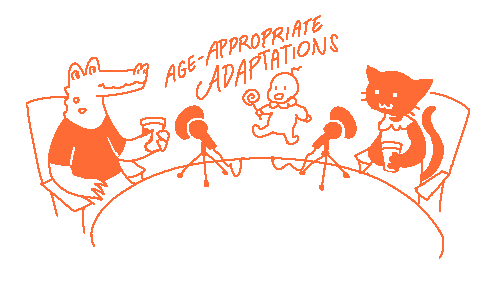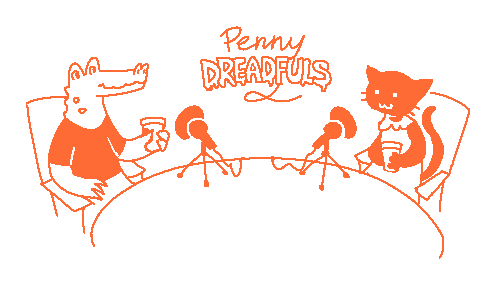
Genres
From thrilling adventures on the high seas to magical worlds brimming with talking animals, the literature of this era offered something truly special. These stories captured a unique blend of Victorian values, like duty and honor, alongside a growing fascination with childhood innocence. It was also a time when writers started to see children as a distinct audience with their own tastes and curiosities—something that was fairly new back then!
So, let’s take a closer look at some of the most popular genres during this period.

Adventure
Adventure stories from the Golden Age swept young readers away on thrilling journeys to distant lands, where excitement and danger waited around every corner. These tales usually featured young heroes who, though often ordinary at first, grew braver and wiser as they faced off against pirates, wild animals, and mysterious foes. Set in exotic and mysterious places—jungles, deserted islands, stormy seas—these stories offered kids a taste of the world beyond their everyday lives, filling their minds with images of uncharted territories and untold dangers.
But these stories were more than just action and suspense; they also celebrated values like courage, quick thinking, and a strong sense of justice. Good always triumphed over evil in the end, leaving readers with a feeling of satisfaction and inspiration. For kids, it was an invitation to dream of adventure, to imagine themselves as daring explorers, and to believe that, like their favorite heroes, they too could be brave, clever, and resilient.
"Treasure Island" by Robert Louis Stevenson (1883)
A landmark in adventure literature, Treasure Island follows young Jim Hawkins as he discovers a treasure map and finds himself swept into a world of pirates and buried gold. The novel introduced some of the most enduring characters in adventure literature, including the charismatic yet dangerous Long John Silver.
"The Jungle Book" by Rudyard Kipling (1894)
This collection of stories centers on Mowgli, a boy raised by wolves in the jungles of India. Throughout his adventures, he learns about the "Law of the Jungle" from animals like Baloo the bear and Bagheera the panther. Kipling’s work blends action with fable-like morality, teaching children about respect for nature and the importance of community.
"Kidnapped" by Robert Louis Stevenson (1886)
In this historical adventure, young David Balfour is kidnapped and thrust into a dangerous journey across the Scottish Highlands. This novel is an exhilarating exploration of loyalty, survival, and Scottish history, making it an ideal adventure story for young readers.
Croc and Cat's Deep Dive into Age-appropriate Adaptations

Fantasy
During the Golden Age of Children's Literature, fantasy stories opened the door to magical worlds where anything could happen. These tales whisked young readers away to places like Wonderland, Neverland, and Oz—worlds filled with talking animals, mischievous fairies, and mythical creatures waiting around every corner. Unlike adventure stories rooted in real-life dangers, fantasy let kids step into the impossible, blurring the line between the everyday and the extraordinary. Often, the journey started in the “real” world before drawing both the hero and the reader into a realm of magic and mystery.
At the heart of these stories were young protagonists on quests—not just to defeat villains or save enchanted lands, but to discover their own inner courage and strength. Fantasy explored timeless themes like good versus evil, with magic often symbolizing self-discovery and growth. For kids, these tales offered more than just a thrilling escape; they were an invitation to imagine, to dream big, and to believe in the magic within themselves.
"Alice's Adventures in Wonderland" by Lewis Carroll (1865)
A pioneering work in children's fantasy, Alice’s Adventures in Wonderland follows a young girl who tumbles down a rabbit hole into a bizarre, nonsensical world. Carroll’s story blends logic with absurdity, presenting a surreal world that challenged Victorian conventions and delighted children with its unpredictability.
"Peter Pan" by J.M. Barrie (1904)
Barrie’s story of the boy who wouldn't grow up captivated young readers with its Neverland setting, a fantastical island populated by pirates, fairies, and mermaids. Peter Pan explores themes of childhood, freedom, and innocence, resonating with generations of children and adults alike.
"The Wonderful Wizard of Oz" by L. Frank Baum (1900)
This classic fantasy novel tells the story of Dorothy Gale, a young girl from Kansas, who is swept away by a cyclone to the magical land of Oz. Her journey to find the Wizard, accompanied by her unusual friends—the Scarecrow, Tin Woodman, and Cowardly Lion—introduced readers to a vibrant and imaginative world that redefined children’s fantasy.
Croc and Cat's Deep Dive into Penny Dreadfuls

Animal Tales
Animal tales were a cornerstone of the Golden Age of storytelling, bringing the animal kingdom to life in ways that helped readers see themselves more clearly. By casting animals as the heroes and villains, these stories could explore human emotions and social values without ever feeling preachy or heavy-handed. A fox might outwit a crow to teach a lesson about pride, or a lion might find unlikely friendship with a mouse, reminding readers of the power of kindness. Some of these tales leaned into whimsy, with animals dressing in little jackets and holding court like humans; others were darker, showing the harsh realities of survival in the wild as a reflection of human struggles. Whether moralistic or mischievous, these stories allowed readers to wrestle with big questions—about loyalty, bravery, greed, and compassion—through the adventures of creatures great and small.

"The Wind in the Willows" by Kenneth Grahame (1908)
A whimsical and cozy tale of friendship, The Wind in the Willows follows the adventures of Mole, Rat, Badger, and the irrepressible Mr. Toad. Grahame’s characters offer reflections on loyalty, home, and the comforts of pastoral life, set against the quiet English countryside.
"Black Beauty" by Anna Sewell (1877)
Though written in an earlier era, Black Beauty became wildly popular during the Golden Age and is considered a classic of animal literature. Narrated by a horse named Black Beauty, this story is both an animal autobiography and a moral tale that criticizes the mistreatment of animals and promotes empathy.
"The Tale of Peter Rabbit" by Beatrix Potter (1902)
Beatrix Potter’s stories, beginning with Peter Rabbit, introduced children to a world of mischievous animals with distinctly human traits. Potter’s charming illustrations and gentle narratives continue to appeal to young readers, subtly teaching lessons about consequence and kindness.

Poetry
During the Golden Age, a resurgence of interest in nursery rhymes and a new genre of nonsense poetry delighted children with their playful language and whimsical ideas. These works encouraged children to revel in the sounds of words and to find joy in absurdity.

"A Book of Nonsense" by Edward Lear (1846)
Edward Lear is credited with popularizing "nonsense poetry," a genre that delighted in the absurd. His Book of Nonsense is filled with limericks that mix humor with whimsy, and the nonsense characters he created are still remembered for their playful absurdity.
"The Cat in the Hat" by Dr. Seuss(1957)
Although released much later, Dr. Seuss was influenced by the playful language and whimsical storytelling of the Golden Age of Children's Literature. His rhythmic verse and vibrant illustrations echo the charm of nursery rhymes and nonsense poetry, celebrating the joy and creativity that define children's literature.
"The Real Mother Goose" by Blanche Fisher Wright (1916)
This collection has a great selection of classic nursery rhymes, all beautifully illustrated. One of the poems included in this collection is the classic Humpty Dumpty.